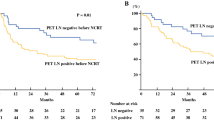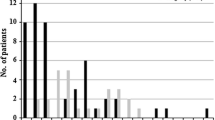Abstract
Background
Induction therapy is not always beneficial for all patients. Therefore, it is important to identify the patients with a high rate of recurrence. The occurrence of lymph node metastases (LNMs) strongly influences the postoperative survival in patients with esophageal cancer. We investigated the usefulness of an LN evaluation by initial 18F-fluorodeoxyglucose (FDG) positron emission tomography (PET) in prediction of postoperative recurrence for patients with resectable esophageal squamous cell carcinoma (ESCC).
Methods
A total of 76 ESCC patients who did not undergo induction therapy, but who did receive a curative resection were divided into PET-node (PET-N) positive (n = 26) and negative (n = 50) groups according to the presence or absence of FDG uptake in LNs. The PET-N status was compared with the size and the number of LNMs, as well as with the survival and failure patterns.
Results
PET positive LNs involved a significantly larger size of metastatic nests than PET negative LNs (P = 0.002). The PET-N negative group showed a higher proportion of patients with 2 or fewer LNMs (92.0%), a higher 5-year relapse-free survival (75.1%) and a higher overall survival (70.0%), and a lower postoperative recurrence (24.0%) than the 15.4, 29.6, 30.3, and 69.2% values in the PET-N positive group, respectively, (P < 0.005). Multivariate analyses identified the PET-N status to be the most significant preoperative risk factor for postoperative recurrence (P = 0.031).
Conclusion
The preoperative PET-N status in patients with resectable ESCC was significantly associated with the size and the number of LNMs and was therefore found to reliably identify the high-risk population for postoperative recurrence.



Similar content being viewed by others
References
Chen G, Wang Z, Liu X, Liu F. Recurrence pattern of squamous cell carcinoma in the middle thoracic esophagus after modified Ivor-Lewis esophagectomy. World J Surg. 2007;31:1107–14.
Dresner SM, Griffin SM. Pattern of recurrence following radical oesophagectomy with two-field lymphadenectomy. Br J Surg. 2000;87:1426–33.
Malthaner RA, Wong RK, Rumble RB, Zuraw L, Members of the gastrointestinal cancer disease site group of cancer care ontario’s program in evidence-based care. Neoadjuvant or adjuvant therapy for resectable esophageal cancer: a systematic review and meta-analysis. BMC Med. 2004;24:35. Available at: http://www.biomedcentral.com/1741-7015/2/35.
Gebski V, Burmeister B, Smithers BM, Foo K, Zalcberg J, Simes J, Survival benefits from neoadjuvant chemoradiotherapy or chemotherapy in oesophageal carcinoma: a meta-analysis, Australasian Gastro-Intestinal Trial Group. Lancet Oncol. 2007;8:226–34.
Cunningham D, Allum WH, Stenning SP, Thompson JN, Van de Velde CJ, Nicolson M, et al. Perioperative chemotherapy versus surgery alone for resectable gastroesophageal cancer. N Engl J Med. 2006;355:11–20.
Mariette C, Piessen G, Briez N, Triboulet JP. The number of metastatic lymph nodes and the ratio between metastatic and examined lymph nodes are independent prognostic factors in esophageal cancer regardless of neoadjuvant chemoradiation or lymphadenectomy extent. Ann Surg. 2008;247:365–71.
Rizk N, Venkatraman E, Park B, Flores R, Bains MS, Rusch V. The prognostic importance of the number of involved lymph nodes in esophageal cancer: implications for revisions of the American joint committee on cancer staging system. J Thorac Cardiovasc Surg. 2006;132:1374–81.
Kunisaki C, Makino H, Kimura J, Oshima T, Fujii S, Takagawa R, et al. Impact of lymph-node metastasis site in patients with thoracic esophageal cancer. J Surg Oncol. 2010;101:36–42.
Wilson M, Rosato EL, Chojnacki KA, Chervoneva I, Kairys JC, Cohn HE, et al. Prognostic significance of lymph node metastases and ratio in esophageal cancer. J Surg Res. 2008;146:11–5.
van Vliet EPM, Heijenbrok-Kal MH, Hunink MGM, Kuipers EJ, Sierserma PD. Staging investigations for oesophageal cancer: a meta-analysis. Br J Cancer. 2008;98:547–57.
Barthet M. Endoscopic ultrasound teaching and learning. Minerva Med. 2007;98:247–51.
Lerut T, Flamen P, Ectors N, Van Cutsem E, Peeters M, Hiele M, et al. Histopathologic validation of lymph node staging with FDG-PET scan in cancer of the esophagus and gastroesophageal junction. A prospective study based on primary surgery with extensive lymphadenectomy. Ann Surg. 2000;232:743–52.
Flamen P, Lerut A, van Cutsem E, De Wever W, Peeters M, Stroobants S, et al. Utility of positron emission tomography for the staging of patients with potentially operable esophageal carcinoma. J Clin Oncol. 2000;18:3202–10.
Komori T, Doki Y, Kabuto T, Ishikawa O, Hiratsuka M, Sasaki Y, et al. Prognostic significance of the size of cancer nests in metastatic lymph nodes in human esophageal cancers. J Surg Oncol. 2003;82:19–27.
Higuchi I, Yasuda T, Yano M, Doki Y, Miyata H, Tatsumi M, et al. Lack of fluorodeoxyglucose 18F uptake in posttreatment positron emission tomography as a significant predictor of survival after subsequent surgery in multimodality treatment for patients with locally advanced esophageal squamous cell carcinoma. J Thorac Cardiovasc Surg. 2008;136:205–12.
Kato H, Kuwano H, Nakajima M, Miyazaki T, Yoshikawa M, Ojima H, et al. Comparison between positron emission tomography and computed tomography in the use of the assessment of esophageal carcinoma. Cancer. 2002;94:921–8.
Sobin LH, Wittekind C. eds. TNM Classification of Malignant Tumors. 6th ed. New York: Wiley, 2002.
Greene FL, Page DL, Fleming ID, Fritz A, Balch CM, Haller DG, et al., eds. AJCC Cancer Staging Manual. 6th ed. New York: Springer-Verlag; 2002.
Fukunaga H, Sekimoto M, Tatsumi M, Ikenaga M, Ohue M, Seshimo I, et al. Clinical relevance of fusion images using (18)F-2-fluoro-2-deoxy-D-glucose positron emission tomography in local recurrence of rectal cancer. Int J Oncol. 2002;20:691–5.
Paul AK, Tatsumi M, Higuchi I, Fukunaga H, Yasuda T, Nishimura T. Gamma camera coincidence imaging with [18F]fluorodeoxyglucose in the pretreatment evaluation of patients with oesophageal cancer. Nucl Med Commun. 2003;24:963–70.
Shiozaki H, Yano M, Tsujinaka T, Inoue M, Tamura S, Doki Y, et al. Lymph node metastasis along the recurrent nerve chain is an indication for cervical lymph node dissection in thoracic esophageal cancer. Dis Esophagus. 2001;14:191–6.
Cerfolio RJ, Bryant AS. Maximum standardized uptake values on positron emission tomography of esophageal cancer predicts stage, tumor biology, and survival. Ann Thorac Surg. 2006;82:391–5.
Edge SB, Byrd DR, Compton CC, Fritz AG, Greene FL, Trotti A. American Joint Committee on Cancer (AJCC) Cancer Staging Manual. 7th ed. Chicago: Springer, 2010.
Rice TW, Rusch VW, Blackstone EH. 2009 AJCC/UICC staging of esophageal cancer. In: Shields TW, Locicero J, Reed CE, Feins RH, eds. General Thoracic Surgery. 7th ed. Vol 2. Amsterdam: Wolters Kluwer, 2009:2013–5.
Zhang HL, Chen LQ, Liu RL, Shi YT, He M, Meng XL, et al. The number of lymph node metastases influences survival and international union against cancer tumor-node-metastasis classification for esophageal squamous cell carcinoma. Dis Esophagus. 2010;23:53–8.
Hsu PK, Wu YC, Chou TY, Huang CS, Hsu WH. Comparison of the 6th and 7th editions of the American joint committee on cancer tumor-node-metastasis staging system in patients with resected esophageal carcinoma. Ann Thorac Surg. 2010;89:1024–31.
Rice TW, Rusch VW, Ishwaran H, Blackstone EH, for the World Esophageal Cancer Collaboration. Cancer of the esophagus and esophagogastric junction. Data-driven staging for the seventh edition of American joint committee on cancer/international union against cancer staging manuals. Cancer. 2010;116:3763–73.
Choi JY, Jang HJ, Shim YM, Kim K, Lee KS, Lee KH, et al. 18F-FDG in patients with esophageal squamous cell carcinoma undergoing curative surgery: prognostic implications. J Nucl Med. 2004;45:1843–50.
Kato H, Nakajima M, Sohda M, Tanaka N, Inose T, Miyazaki T, et al. The clinical application of 18F-fluorodeoxyglucose positron emission tomography to predict survival in patients with operable esophageal cancer. Cancer. 2009;115:3196–203.
Sepesi B, Raymond DP, Polomsky M, Watson TJ, Litle VR, Jones CE, et al. Does the value of PET-CT extend beyond pretreatment staging? An analysis of survival in surgical patients with esophageal cancer. J Gastrointest Surg. 2009;13:2121–7.
Shenfine J, Barbour AP, Wong D, Thomas J, Martin I, Gotley DC, et al. Prognostic value of maximum standardized uptake values from preoperative positron emission tomography in resectable adenocarcinoma of the esophagus treated by surgery alone. Dis Esophagus. 2009;22:668–75.
Malthaner R, Collin S, Fenlon D, Rhodes S. Preoperative chemotherapy for resectable thoracic esophageal cancer (Review). Cochrane Database Syst Rev. 2006; 3: Art. No.:CD001556. doi:10.1002/14651858.CD001556.pub2.
Acknowledgment
The authors thank Professor Yasutaka Chiba from the department of Clinical Research Center, Kinki University School of Medicine for dedicated advices regarding statistical analysis and Professor Makoto Hosono from the PET department of Kinki University School of Medicine for comments in the procedure of PET examination.
Author information
Authors and Affiliations
Corresponding author
Additional information
The authors have no financial disclosure or commercial sponsorship.
Rights and permissions
About this article
Cite this article
Yasuda, T., Higuchi, I., Yano, M. et al. The Impact of 18F-Fluorodeoxyglucose Positron Emission Tomography Positive Lymph Nodes on Postoperative Recurrence and Survival in Resectable Thoracic Esophageal Squamous Cell Carcinoma. Ann Surg Oncol 19, 652–660 (2012). https://doi.org/10.1245/s10434-011-1928-4
Received:
Published:
Issue Date:
DOI: https://doi.org/10.1245/s10434-011-1928-4




